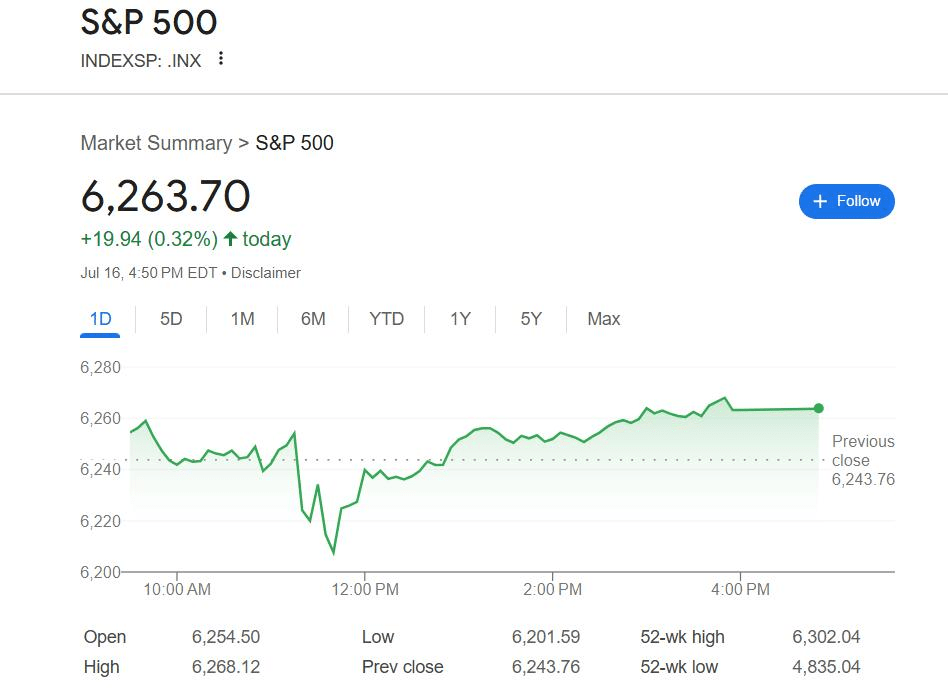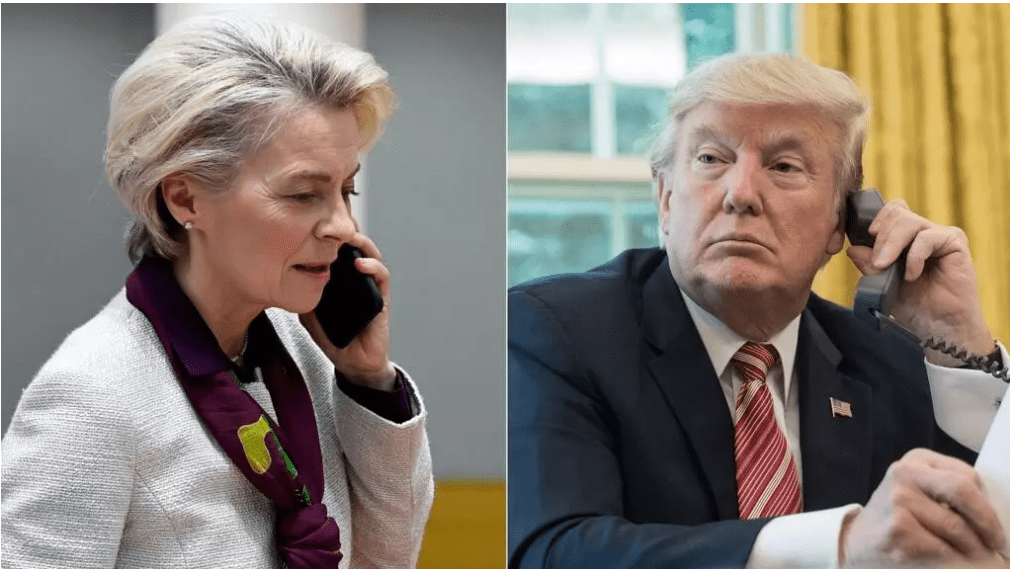#关税 news:
On July 16, Eastern Time Wednesday, Trump stated at the White House that he would notify over 150 countries about the tariff rates that the U.S. would impose. The so-called 'major trade agreement' will involve sending tariff letters to 150 countries. He said:

During Trump's aforementioned speech, U.S. stocks were still under the downward pressure of the news that Trump would fire Powell, with the S&P 500 index down over 0.1%, the Nasdaq down nearly 0.2%, the Dow almost flat, and the Philadelphia Semiconductor Index narrowing its decline to within 1.7%. However, afterward, the Dow returned to an upward trend, and during the U.S. stock market's midday, the S&P and Nasdaq turned positive. The Philadelphia Semiconductor Index, which had previously fallen by 2.8%, narrowed most of its losses.
Ultimately, all three major U.S. stock indices closed slightly higher, with the S&P up over 0.3%, the Nasdaq up nearly 0.3%, the Dow up over 0.5%, and the Philadelphia Semiconductor Index down nearly 0.4%.

Analysis by Lao Zhu:
Trump's tariff knife is tearing apart the global trade system. He plans to set a single tariff number for 150 countries, imposing a 10% or 15% tariff on smaller countries, with a real 'nuclear weapon' to be unleashed on August 1.
This is by no means a bluff. Looking back at the 'Liberation Day' tariff plan announced in March this year, Bitcoin plummeted 4.6% within an hour, while Ethereum simultaneously dipped 5.7%, with billions in leveraged positions evaporating in an instant.
On July 14, when Trump suddenly announced a 30% tariff on Mexico and the EU, Bitcoin again took the lead in diving. This policy repetition has formed a 'threat-reverse-delay' death loop, forcing global businesses into a desperate situation.
Data from the Tax Policy Center shows that by early August, tariffs on women's clothing will soar to 48%, books 40%, and baked goods 22%. Yale's Budget Lab estimates an even more shocking figure — the average tariff faced by consumers has reached 18%, a record high since 1934.
'Rising import costs impact every link in the supply chain,' warned the CEO of Kronos Research. 'Companies either absorb the costs themselves or pass them on to consumers.' Low- and middle-income families are bleeding out in this trade war.
While traditional markets struggle in the tsunami of tariffs, Bitcoin has staged an epic comeback. On Monday, after Trump adjusted tariff rates, the major U.S. stock indices collectively closed lower, but Bitcoin defied the trend, breaking through $118,000 and setting a new historical high.
This marks a stunning transformation of Bitcoin from a 'risk asset' to a 'macro hedging tool.' Kronos Research CEO accurately points out, 'When tariffs exacerbate inflation and market turmoil, investors value Bitcoin's scarcity and decentralization even more.'
On-chain data confirms this paradigm shift: Despite the market shock caused by Trump's tariff policy, U.S. spot Bitcoin ETFs have seen a net inflow of $1.03 billion for seven consecutive days, and BlackRock's IBIT fund has achieved an astonishing record of net inflows for 30 consecutive days.
Institutional holdings have surged from 10% in 2020 to over 40% in 2025. When the Abu Dhabi sovereign wealth fund massively holds Bitcoin ETFs, and the Swiss National Bank indirectly allocates Bitcoin through MicroStrategy, the rules of the game have been permanently changed.
The anti-tariff logic of Bitcoin is rooted in profound financial realities. BlackRock CEO Larry Fink candidly stated in his annual letter to investors: Bitcoin is challenging the dollar's status as the global reserve currency.
Famous trader Arthur Hayes's analysis is even sharper: Under the massive government debt and political pressure, the Federal Reserve may be forced to finance the government through quantitative easing, recreating the inflation of the 1970s, which would drive Bitcoin prices skyrocketing.
More critically, Trump's tariff policy is accelerating the collapse of dollar hegemony. The 'local currency settlement pilot clause' in the China-U.S. trade truce agreement is quietly eroding the foundation of dollar trade settlement. History does not lie — during the trade war from 2018 to 2020, Bitcoin ultimately broke through $20,000 after an initial pullback.
Bitwise data reveals an even more astonishing supply-demand imbalance: U.S. corporate Bitcoin purchases in 2025 have exceeded new supply by more than three times. Daily new Bitcoins from miners have dropped from 900 to 450, while BlackRock's IBIT alone demands 800 Bitcoins daily. This structural shortage is evolving into a price nuclear explosion during the halving cycle.
The technicals are sending a dazzling buy signal. Bitcoin has strongly broken through $121,500, completely shattering the short positions. Analyst Web3Niels sent an urgent message: after breaking the key resistance zone of $119,000 to $120,000, $135,000 to $140,000 will become the next target for attack.
The wild bets in the options market confirm the technical judgment. The open interest for $100,000 call options on Deribit is approaching $1.2 billion, with contracts concentrated in the $95,000 to $120,000 range. Traders are betting real money that Bitcoin will surge violently.
The target price of Wall Street institutions has entered a frenzy bidding mode. Standard Chartered's Geoffrey Kendrick publicly apologized for being 'too conservative with a $120,000 target for the second quarter' and has set the annual target at $200,000. Even more astonishing is the Trump family's prediction at the Bitcoin 2025 conference — reaching $170,000 by the end of 2026.
Short-term fluctuations? That’s just an excuse for the weak. The four-hour chart shows that the range of $99,700 to $100,500 has formed a 'fair value gap,' and even if there is a pullback, it is a golden pit for bulls to accumulate. True warriors will only advance amidst the cannon fire.
In this global trade war, blockchain technology is becoming the secret weapon for business survival. 'Blockchain provides transparency and immutable on-chain records, giving supply chains powerful resilience,' revealed the CEO of Kronos Research.
When tariff policies become unpredictable, the real-time visibility of blockchain helps companies instantly verify the origin of products and track shipments, avoiding exorbitant fines. This bulletproof solution is the Noah's Ark of turbulent times.
Hong Kong's stablecoin strategy further reveals a national-level layout. HashKey Chief Analyst Jeffrey Ding disclosed that Hong Kong is issuing the first batch of stablecoin licenses in limited quantities, focusing on cross-border payment applications to help developing countries cope with financial risks. When fiat currency bridges collapse, stablecoins are becoming a secret channel for capital flight.
The Trump family has clearly sniffed out business opportunities, as their WLFI agency launched the dollar stablecoin USD1, targeting the dominance of USDT and USDC. Despite conflicting interests, the U.S. is establishing a regulatory framework for stablecoins through the (Genius Act), paving the way for digital dollar hegemony.
History will not forget this ironic scene: When Trump imposed a 30% tariff on Mexico, the Mexican peso plummeted, but the installation of Bitcoin ATMs in Mexico City surged by 37% in just one week.
The tariff ruling by the U.S. International Trade Court was like a deep-sea bomb, as Bitcoin broke through $109,000, with a single-day increase of 1.86%. The alarms sounded across Wall Street trading desks, and short positions evaporated in seconds.
Standard Chartered has urgently raised its target price to $200,000, and BlackRock's ETF is consuming 800 Bitcoins daily — nearly double the daily output of miners. As tariff bombs destroy traditional trade channels, Bitcoin is becoming a digital Noah's Ark.

Lao Zhu summarizes:
As EU automakers lament the 30% tariff, and Mexican avocados rot in the fields, a bulletproof supply chain based on blockchain is rising: companies are avoiding tariff landmines through on-chain traceability and cross-border settlement free from dollar constraints.
This article is just an appetizer! Exclusive in-depth analysis, practical tutorials, and the latest developments on [core theme of the article]... Click on the avatar and follow me.